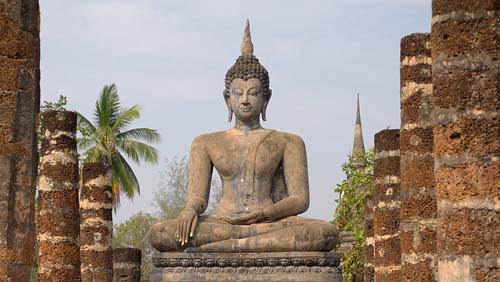Thai Language
| Online Dictionaries | Lexitron | Longdo | thai2english | thai-language.com |
| Learning Ressources | thai-language.com | learningthai.com | learn-thai-podcast | langhub.com |

The Thai language ("phasa thai"), is the national and official language of Thailand and the mother tongue of the Thai people, Thailand's dominant ethnic group. Thai is a member of
the Tai group of the Tai-Kadai language family. The Tai-Kadai languages are thought to have originated in what is now southern China. It is a tonal and analytic language. The combination of tonality, a complex orthography, relational markers and a distinctive phonology
can make Thai difficult to learn for those who do not already speak a related language.
Standard Thai, also known as Central Thai or Siamese, is the official language of Thailand, spoken by about 25 million people (1990) including speakers of Bangkok Thai (although the latter is sometimes considered as a separate dialect). Khorat Thai is spoken by about 400,000 (1984) in Nakhon Ratchasima; it occupies a linguistic position somewhere between Central Thai and Isan on a dialect continuum,
and may be considered a variant or dialect of either. In addition to Standard Thai, Thailand is home to other related Tai languages, including:
1. Isan (Northeastern Thai), the language of the Isan region of Thailand, is considered by some to be a dialect of the Lao language, which it very closely resembles (although it is written in the Thai alphabet). It is spoken by about 15 million people (1983).
2. Nyaw language, spoken mostly in Nakhon Phanom province, Sakhon Nakhon province, Udon Thani province of Northeast Thailand.
3. Galung language, spoken in Nakhon Phanom province of Northeast Thailand.
4. Lü (Tai Lue, Dai), spoken by about 78,000 (1993) in northern Thailand.
5. Northern Thai (Lanna, Kam Meuang, or Thai Yuan), spoken by about 6 million (1983) in the formerly independent kingdom of Lanna (Chiang Mai).
6. Phuan, spoken by an unknown number of people in central Thailand and Isan.
7. Phu Thai, spoken by about 156,000 around Nakhon Phanom province (1993).
8. Shan (Thai Luang, Tai Long, Thai Yai), spoken by about 56,000 in north-west Thailand along the border with the Shan States of Burma (1993).
9. Song, spoken by about 20,000 to 30,000 in central and northern Thailand(1982).
10. Southern Thai (Pak Thai), spoken about 5 million (1990).
11. Thai Dam, spoken by about 20,000 (1991) in Isan and Saraburi province.
Many of these languages are spoken by larger numbers outside of Thailand. Most speakers of dialects and minority languages speak Central Thai as well, since it is the language used in schools and universities all across the kingdom. Standard Thai is composed of several distinct registers, forms for different social contexts.
Script. The Thai alphabet is derived from the Khmer alphabet, which is modeled after the Brahmic script from the Indic family. Much like the Burmese adopted the Mon script (which also has Indic origins), the Thais adopted and modified Khmer script to create their own writing system. While the oldest known inscription in the Khmer language dates from 611 AD, inscriptions in Thai writing began to appear around 1292 AD.
Transliteration. There is no universal standard for transliterating Thai into English. For example, the name of King Rama IX, the present monarch, is transliterated variously as Bhumibol, Phumiphon, or many other versions. Guide books, text books and dictionaries may each follow different systems. For this reason, most language courses recommend that learners master the Thai alphabet. In scholarly usage, French scholars tend to romanize Thai with a letter-for-letter transcription according to the original Sanskrit value of the characters. Anglophone scholars generally prefer either a simplified phonetic rendering or some variation on the International Phonetic Alphabet.
Grammar. From the perspective of linguistic typology, Thai can be considered to be an analytic language. The word order is Subject Verb Object, although the subject is often omitted. Thai pronominal system varies according to the sex and relative status of speaker and audience.
Vocabulary. Other than compound words and words of foreign origin, most words are monosyllabic. Historically, words have most often been borrowed from Sanskrit and Pali; Buddhist terminology is particularly indebted to these. Old Khmer has also contributed its share, especially in regard to royal court terminology. Since the beginning of the 20th century, however, the English language has had the greatest influence. Also, many Teochew Chinese words are used, some replacing existing Thai words.
|
 |
